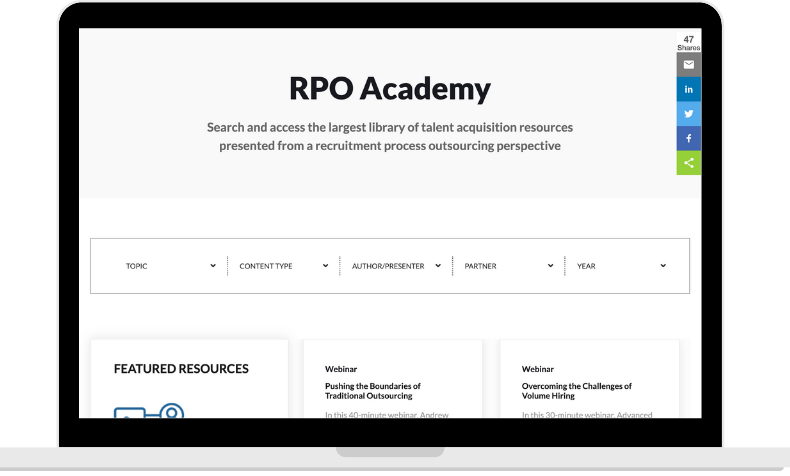-min.jpg?width=800&height=533&name=iStock-2171383097%20(1)-min.jpg)
Talent acquisition faces a crucial inflection point. Candidate engagement rates have dropped 40 percent over five years while automation increases and personalization declines. Automated interactions contribute to 56 percent of job seekers feeling undervalued. Leigh Cuevas, Senior Director of direct sourcing at AgileOne RPO stated during a recent RPOA Leadership Forum webinar. “The problem extends beyond declining engagement,” she said. “Brand consistency suffers across fragmented recruitment channels, with 64 percent of candidates questioning company culture due to inconsistent messaging.”
Cuevas also noted that traditional models create additional barriers by separating sourcers, recruiters, and hiring managers. These disconnects slow processes and dilute brand messaging, resulting in longer time-to-fill, reduced candidate quality, and frustrated hiring managers. These challenges demand a strategic approach where direct sourcing transforms from a tactical process into a connectivity engine that aligns technology with human connection.
This post explores Cuevas’s presentation on how direct sourcing transforms recruitment by balancing technology with human connection, delivering measurable results, and creating sustainable talent engagement strategies.
Direct Sourcing: A Human-Centered Framework for Modern Recruitment
Direct sourcing offers a strategic solution that transcends conventional definitions. Rather than viewing it as a tactical process, forward-thinking organizations embrace direct sourcing as "the connectivity across your entire workforce."
Cuevas explained direct sourcing "brings your brand to the forefront and center. It allows you to build and curate a pipeline of engaged, pre-vetted talent that reflects who you are as an organization."
At its core, effective direct sourcing builds branded talent communities where candidates engage with your organization before positions open. These communities create pipelines of pre-vetted talent reflecting your organizational values and culture. When needs arise, these candidates move quickly through your process, she noted.
"Think of direct sourcing like Netflix versus channel surfing," Cuevas said. "Instead of sifting through random candidates, direct sourcing uses a curated talent pool based on people who already have connected to your company."
To implement this approach successfully, organizations must understand the foundational elements that make direct sourcing truly effective.
The Core Principles of Effective Direct Sourcing
Successful direct sourcing strategies balance innovation with human connection. Cuevas pointed out four key principles that differentiate transactional recruiting from strategic talent engagement that delivers measurable business results.
1) People-Driven, Tech-Supported
Technology helps find talent faster, but sourcers must understand context. They need to align candidate backgrounds with team dynamics, role requirements, and company culture. Many organizations rely heavily on AI-driven solutions without this human element.
"When combining technology with the art of human connection, that's when it works," Cuevas said. "When those two are absolutely going hand in hand, your sourcing team should be passionately invested in every role they're recruiting on."
Organizations that blend tech with human sourcing see 31 percent faster time to hire and measurable improvements in candidate quality. This balanced approach delivers speed without sacrificing personalization.
AI is no longer optional — but it's not enough on its own. The 2025 RPO Trends Report makes it clear: Organizations seeing the biggest recruitment wins combine technology with purpose, human connection, and measurable effect.
2) Tailored, Not Template-Driven
Direct sourcing fails when treated as one-size-fits-all. Every organization needs its own approach reflecting its unique brand story. Whether insourcing, using a decentralized model, or focusing on specialized roles, the structure must adapt to business needs.
Cuevas noted that "many organizations and many direct sourcing programs really lean on those pre-packaged solutions because it's easy. But if you do the leg work in the beginning, it pays off in the next six to 12 months."
Organizations using custom talent curation aligned with business priorities report 40 percent higher retention rates.
3) Passionate Sourcing
Effective sourcing sparks meaningful connections. When sourcers lead with energy and belief in your mission, they create conversations that leave candidates energized and inspired.
"When you have that conversation that you were left energized, where someone's passion was so contagious, you walked away inspired, excited and completely sold. For me, that is passionate sourcing," Cuevas said.
This passion moves talent and fills pipelines with people who want to join your story. Passionate sourcers don't just find talent; they attract believers who connect with your mission and values.
4) Persistent Curiosity
Great sourcing requires continuous exploration. Sourcers should look beyond resumes, tap adjacent industries, and engage networks beyond LinkedIn. Organizations that depend on pre-built talent pools limit their access to hidden talent.
"Your team should excel relentlessly in curiosity and finding new ways," Cuevas said. "They should continually explore new avenues and really keeping talent pools fresh and engaged and relevant."
This curiosity uncovers hidden gems typical sourcing misses, giving your organization first access to untapped, high-potential talent.
Case Study: Transforming an Aerospace Manufacturer with Strategic Direct Sourcing
These principles create the foundation for successful direct sourcing, but seeing their effect requires examining real-world application. Cuevas provided an intriguing example to examine.
A leading aerospace manufacturer struggled with significant recruitment challenges. Their model was recruiter-driven and reactive, with siloed teams functioning separately. The broader hiring process lacked consistency in storytelling and brand alignment.
Time-to-fill exceeded benchmarks, and retention declined, especially in specialized engineering and operations roles. The team of 21 recruiters and sourcers needed a strategic overhaul.
The transformation focused on four core areas:
- Sourcing-First Model: The team restructured to position sourcers at the top of the funnel, owning candidate engagement and brand building. Recruiters concentrated on candidate conversions.
- Brand Storytelling Training: "We unified our messaging through a custom training series using the head, the heart and the hands framework," Cuevas said. This approach aligned communication across all candidate touchpoints.
- Market-Driven Strategies: Real-time labor insights, competitor analysis, and skills benchmarking informed strategic decisions. This data refined channels and messaging for maximum relevance.
- Enhanced Engagement: Generic outreach was replaced with personalized, data-informed messaging. Subject line testing and consistent branding across all touchpoints created a cohesive candidate experience.
The results proved transformative. First-year retention increased from 72 percent to 87 percent. Time-to-fill dropped from 56 days to 28 days. Outreach response rates more than doubled, jumping from 19 percent to 42 percent.
Looking to Put Strategy into Action? Explore the iCoCo Marketplace — a curated network of RPO providers specializing in specific industries, roles, and geographies. Find the right partner to build your direct sourcing strategy and accelerate hiring outcomes.
Six Questions to Evaluate Your Direct Sourcing Strategy
With these principles and case study in mind, organizations must evaluate their current approach to direct sourcing through a strategic lens.
Cuevas gave webinar attendees the following assessment questions to help talent leaders identify gaps and opportunities in their direct sourcing strategy. She noted that these reflection points serve as a diagnostic framework for determining where to focus improvement efforts.
- Are your sourcers storytellers or just searchers? "Are they equipped to communicate your brand story with purpose, with your passion and relevance to the organization?" Cuevas asked.
- Is your sourcing model proactive or reactive? Are you continuously building talent communities or starting from zero with each new requisition?
- Is your outreach human-centered or automated noise? "Does your messaging feel personal and value driven, or is it templated and transactional?" Cuevas said.
- Do your sourcers and recruiters operate as one team? Is there alignment across the candidate journey from attraction to conversion?
- Are you using data to lead, not just report? Cuevas emphasized that "data should be telling you a story" and should shape where, how, and who you engage with.
- Are you investing in long-term engagement or short-term fixes? Are your talent communities strategically aligned to workforce plans and nurtured even when not actively hiring?
The Challenge: Make One Bold Move This Quarter
After evaluating your current approach, success requires commitment to actionable change that prioritizes human connection in your direct sourcing strategy.
"What's one bold step you can take this quarter to make your sourcing more strategic, most importantly, more human and more community driven?" Cuevas challenged.
The future of talent acquisition demands a balanced approach where technology extends reach while human connection builds relationships. Organizations that embrace this approach see faster hiring, better candidate quality, and improved retention.
By aligning sourcers with your brand, investing in passionate storytelling, and nurturing long-term talent communities, your organization can transform recruitment from a transactional process into a competitive advantage.
As you identify your organization’s next bold move, use insights from the 2025 RPO Trends Report to evaluate how well your strategy aligns with what today’s leading employers and RPO buyers.













